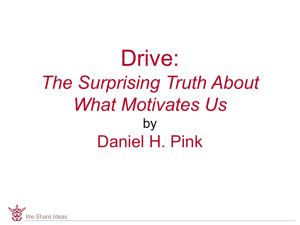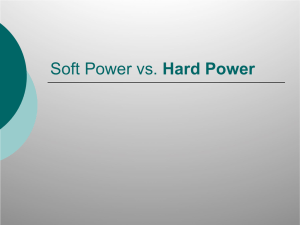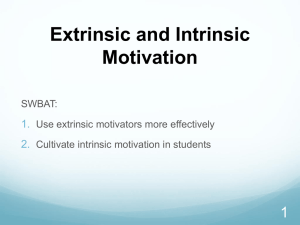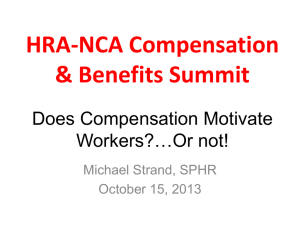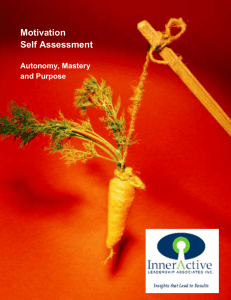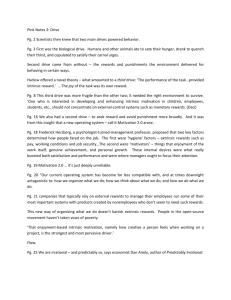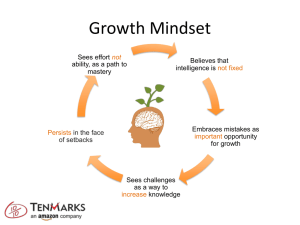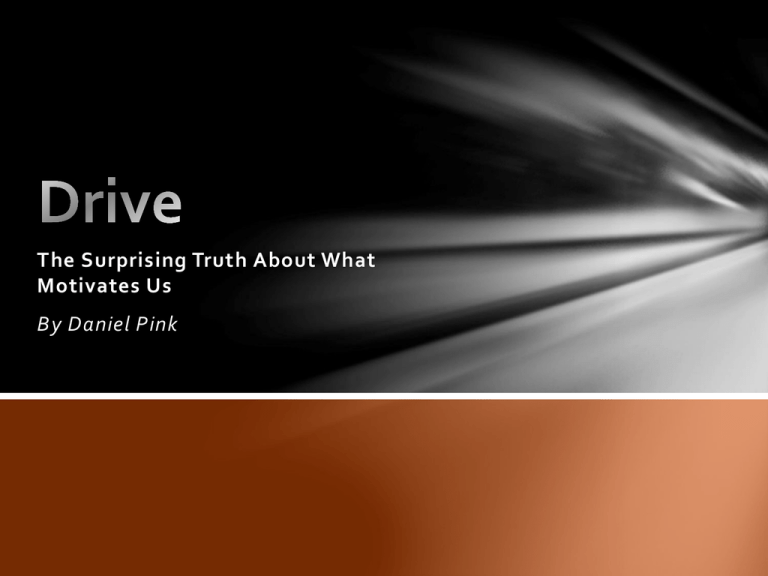
The Surprising Truth About What
Motivates Us
By Daniel Pink
Neighborhood Guides
Recognize that people motivate themselves
But it is up to the Guide to create an
environment that ignites each person’s own
motivation
Understanding human motivation can help
us create that environment
Human Motivation 1.0
Biological Drive: Hunger, Thirst & Sex
An operating system not much different
from apes and other animals.
Worked well and served us until it didn’t
Human Motivation 2.0
Extrinsic Drive: Responding to rewards and
punishments in our environments (Carrots
and Sticks)
This operating system upgrade from Motivation 1.0 began
when we had to cooperate with each other to survive.
More complex societies were built
We had to suppress our biological drives. A more accurate
assumption is that humans are more than our biological
urges. We seek reward and avoid punishment more
broadly. Humans have uniquely mastered this operating
system and channeled this drive to develop everything
from contract law to convenience stores.
Human Motivation 2.0
Businesses have been operating under this
system for a long time.
Early 1900’s - Frederick Taylor – Scientific
Management – reward employee behaviors you
want and punish those you don’t want.
Assumes humans aren’t much more than horses –
dangle a carrot in front of our noses or hit us with
a sharper stick and we will go in the right
direction.
Human Motivation 3.0
Intrinsic Drive: Since the middle of the 20 th
century, scientists have been studying this 3 rd
drive.
Businesses haven’t caught up with this new
understanding.
Motivation 2.0 is so ingrained in us, we don’t even
think about it.
The Problem with Carrots & Sticks
Motivation 2.0 – highly unreliable – sometimes it
works and many times it doesn’t.
3 Defects - not only incompatible with but can be
antagonistic to:
The way we organize what we do
The way we think about what we do
The way we do what we do
The Way we Organize what we Do
Imagine it is 1995.
You sit down with an accomplished economist
and say – I’m going to describe two new
encyclopedias – one just out and the other to be
launched in a few years. You have to predict
which will be more successful in 2012.
Two Encyclopedias
The first is Microsoft – it will pay professional
writers and editors to craft 1000’s of articles –
overseen by well paid managers to ensure its
completed on budget and on time – it will be sold
on CDs then online
The second won’t come from a company. It will
be created by tens of thousands of people who
write and edit articles for fun. No one will be paid
a dollar, a euro or a yen for their work. And the
encyclopedia will exist online and will be free.
Open Source
Tens of thousands of software projects – Linux,
Firefox, etc.
But also open source:
• Cookbooks, textbooks
• Car design
• Medical research
• Legal briefs
• Stock photography
• Prosthetics
• Credit unions, cola, beer, etc.
Open source – relies on Intrinsic
Motivation
No vow of poverty
Can burnish reputations, improve earning
potential, hone skills
MIT study – Motivation for open source – How
creative a person feels when working on the
project is the strongest and most pervasive driver
Participants reached a state of “flow”
More than open source
Two types of businesses – profit and nonprofit
One makes money, the other does good.
Publically traded – one overriding responsibility –
maximize shareholder gain
2008 – Vermont – 1st state to allow a new type of
business – low-profit, limited liability corporation
– operates like a for-profit but its primary aim is
to offer significant social benefits
Social businesses, for-benefit organizations, and
B Corporations – incentives favor long-term value
and social impact
The Way we Think about What we Do
In the past, economics taught us that humans are
wealth maximizers – we will always do what is
best for us
An experiment... Someone gives me $10 to share
with you
2002 – Nobel Award in economics went to Daniel
Kahneman, a psychologist. He revealed that
humans are not always rational calculators of our
economic self-interest.
Humans are Predictably Irrational
This calls into question the assumptions of
Motivation 2.0 – sometimes these motivators
work, sometimes they don’t
We leave lucrative jobs to take low-paying ones that have
a clearer sense of purpose
We work to master the piano on the weekends, although
we have little hope of making a dime from playing one
We play with puzzles even though we don’t get a few
dollars for solving them
“It is inconceivable that people are motivated solely or
even mainly by external incentives.”
Bruno Frey
The Way we Do what we Do
Frederick Taylor’s Ghost – “Work” consists mainly
of uninteresting tasks. The only way to get people
to them is to incentivize them properly and
monitor them carefully.
Jobs have become more complex, more
interesting, and more self-directed.
Yes, even the job of caring for human beings
2 Kinds of Jobs
Algorithmic – You follow a set of established
instructions down a single pathway to one conclusion
(there is an algorithm for solving it)
Heuristic – The opposite. Because there is no
algorithm for it, you have to experiment with
possibilities and devise a novel solution
Most work in North America, Europe, Australia and
Japan has become more creative and less routine.
Routine work has moved to India, Bulgaria, China and
the Philippines where it can be done cheapest.
Heuristic Tasks
Intrinsic motivation principle of creativity:
“Intrinsic motivation is conducive to creativity;
controlling extrinsic motivation is detrimental to
creativity.”
Carrots and sticks work well for algorithmic tasks
but are devastating for heuristic ones.
There may be short-term gains, but eventually
carrots and sticks will crush creativity.
Motivation 2.0
Comes from the assumption that all work is dreary
and not inherently enjoyable.
Researchers Deci & Csikszentmihalyi – found that
people are much more likely to report having
“optimal experiences” on the job than during leisure.
And that adding extrinsic rewards on top of
inherently interesting tasks can often dampen
motivation and diminish performance
Carrots and sticks can achieve the opposite of what
we want them to achieve.
If work is dreary
Then we need a lot of people to carefully monitor
people so they don’t shirk their duties.
Routine, uninteresting jobs require direction, nonroutine, more interesting work depends on selfdirection.
Motivation Caveat
The starting point for any discussion on
motivation:
People have to earn a living.
If someone’s baseline rewards are not adequate
or equitable her focus will be on the unfairness of
her situation and the anxiety of her circumstance.
Without adequate baseline rewards, you get very
little motivation at all.
Questions for You
Is hands-on care-giving Algorithmic or Heuristic
work?
As managers, how do we treat it?
What results do we get when we use Motivation
2.0?
Douglas MacGregor
MIT Management professor – 1960 published The
Human Side of Enterprise
Those running companies were operating from faulty
assumptions about human behavior. Offered a
different view:
•
Humans take as much interest in their work as
they do in their rest or play
•
Creativity and ingenuity are widely distributed in
the population
•
Under proper conditions people will seek
responsibility
An upgrade to Motivation 3.0
The three elements of intrinsic motivation:
• Autonomy
• Mastery
• Purpose
Autonomy
Our human “default setting” is to be autonomous and
self-directed.
Circumstances, including management, often
conspire to change that default setting and change
our behavior.
To encourage creativity and ingenuity, people need
autonomy over TASK (what they do), TIME (when
they do it) TEAM (who they do it with), and
TECHNIQUE (how they do it)
Companies that offer autonomy out-perform those
who don’t.
Mastery
Motivation 2.0 requires “compliance.” Motivation 3.0
demands “engagement.”
Only engagement can produce mastery – becoming
better at something that matters.
Mastery begins with “flow” – optimal experiences
when the challenges we face are exquisitely matched
with our abilities.
Smart workplaces supplement day-today activities
with “Goldilocks” tasks – or allow workers to sculpt a
part of their day – even low-autonomy jobs can
become fun and produce flow.
Mastery abides by 3 rules
1. Mastery is a mindset: it requires the capacity to
see your abilities not as finite, but infinitely
improvable
2. Mastery is a pain: it demands effort, grit, and
deliberate practice
3. Mastery is an asymptote: it is impossible to
fully realize, which makes it simultaneously
frustrating and alluring
Purpose
Humans by their nature seek purpose – a cause greater
and more enduring than themselves
Until recently, businesses have seen purpose as a nice
ornamental accessory
With the Boomers and their own aging, that is changing
Purpose maximization is taking place along side profit
maximization
The New Purpose Motive
Goals that use profit to reach purpose
Words that emphasize more than self-interest
Policies that allow people to seek purpose on their own
terms
In the Future
The most successful organizations will be those
that can harness intrinsic motivation by creating
environments where autonomy, mastery, and
purpose are the operating system, and the use of
carrots and sticks is minimized.

